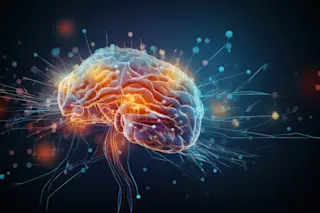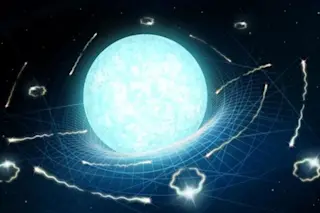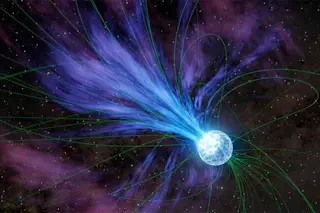When Pliny the Elder first beheld a magnet, he was utterly blown away. “What phenomenon is more astonishing?” he wrote later. “Where has nature shown greater audacity?” In the fifth century, St. Augustine of Hippo agreed, declaring himself “thunderstruck” by the sight of a magnet lifting several metal rings. Magnets, he announced, were proof that miracles were real and that God, therefore, existed. “Who would not be amazed,” Augustine marveled, “at this virtue of the stone?” Certainly the 4-year-old Albert Einstein was amazed. When his father showed him a compass, it was young Albert’s first clue, he later wrote, that there was “something behind things, something deeply hidden,” and he spent his life trying to find it.
What was it that so impressed these men? These giants? It was that a magnet could move things without touching them. In science this feat is known as “action at a distance,” and it was something that used to impress people. People would see a magnet move a piece of metal, or a moon trapped in orbit around a planet, or a man in a restaurant levitate a saltshaker just by looking at it, and they would wonder how it was possible. After all, as Isaac Newton pointed out in his Principia, the notion “that one body may act upon another at a distance through a vacuum without the mediation of anything else, by and through which their action and force may be conveyed from one to another, is to me so great an absurdity that I believe no man who has in philosophic matters a competent faculty of thinking could ever fall into it.”
Me neither. But it would appear that guys like Einstein, Newton, and myself —guys who see Thing A controlling Thing B at a distance and wonder about it—are all of a sudden rather thin on the ground. You see, at the end of last year, while vacationing with my family at an undisclosed rural location, I found myself reclining by a fireplace with a book titled Electronics for Dummies by Gordon McComb and Earl Boysen.
On page 10 of that volume, I read that electrons repelled each other without touching, in the same way that two magnets will if you align them with their like poles facing. At this point, realizing that I must have either slept through or forgotten the high school physics class where it was explained how magnets manage that singular feat of interacting with each other at a distance, I set out on what I assumed would be a minutes-long odyssey to understand the phenomenon. Seventy-one days later, I am here with astonishing findings.
For one thing, as far as I can tell, nobody knows how a magnet can move a piece of metal without touching it. And for another—more astonishing still, perhaps—nobody seems to care.
This information was not easy to come by. My copy of Electronics for Dummies now shares a shelf with Mathematics of Classical and Quantum Physics by Frederick Byron Jr. and Robert Fuller. Should a doctor at any point take a cross section of my brain, she will find patches of scarring and dead tissue, souvenirs of the time I pursued the mystery of magnetism across the 11-dimensional badlands of string theory. Students of human pathos may one day cherish the 16-minute recording of me, with my 100 percent positive-feedback rating as an eBay purchaser, failing to make renowned physicist Steven Weinberg, who won a Nobel for unifying electromagnetism with the so-called weak force, admit that he can’t explain how a magnet holds a dry-cleaning ticket to the door of a refrigerator.
But as far as I can tell—and isn’t the point of science that all its bigger propositions come accompanied by this noble caveat?—he really can’t. When you get right down to it, the mystery of magnets interacting with each other at a distance has been explained in terms of virtual photons, incredibly small and unapologetically imaginary particles interacting with each other at a distance. As far as I can tell, these virtual particles are composed entirely of math and exist solely to fill otherwise embarrassing gaps in physics, such as the attraction and repulsion between magnets. And as far as I can tell, because I’ve had it repeatedly and rather pityingly told to me, to want to pursue the matter any further is an impulse that marks its sufferer out as a man who doesn’t know an awful lot about physics, or science, or the pursuit of truth in general.
What I have learned, in other words, after 71 days of strenuous research, is that I and my fellow Dummies no longer have a seat, if we ever did, at the dinner table of science. If we’re going to find any satisfaction in this gloomy vale of misery and mystery, we’re going to have to take matters into our own hands and start again, from first principles.
On this day, this very hour, starting with the magnets holding my gym’s yoga schedule to the creaking door of my filthy refrigerator, it begins.














